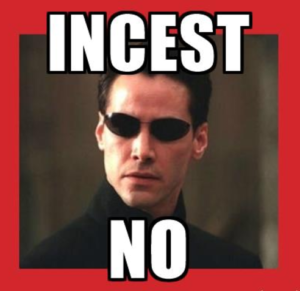Familial Relationships
Long before Abner Doubleday invented the game of baseball in 1839, and long before the first double header was ever played in 1882 (between Providence and Worcester), our Sages, or was it Ezra Hasoifer (the scribe), first introduced the concept of double headers. Accordingly, this week, just like last, you will again have the pleasure, of hearing not one, but two parshas. Grada both parshas tell us in no uncertain terms that certain pleasures, mistama the one’s that many of you are attracted to -say it’s not so- are verboten. And why do we have double header parshas? Shoin, we have previously discussed this issue ober bikitzur (in short), the answer goes like this. The heylige Toirah contains a total of 54 parshas and we have but 52 shabosim. Moreover, as you all know, when Yom Tov coincides with the heylige shabbis, its laining trumps the parsha and shoin. All of a sudden, in certain years, we need to double-up certain parshas in order to adhere to Ezra’s takono (enactment) that we must complete the entire cycle of Toirah readings each year on Simchas Toirah. Got all that? Veyter.
 This coming shabbis, as we listen to Parshas Achrei Mois and Kedoishim, one could get the impression that these two parshios in the heylige Toirah are primarily about sexual relations, all of the forbidden variety. One wouldn’t be all that wrong. There is avada other content and every word of the heylige Toirah is taka holy, meaningful and special, ober none of it will chap you quite the same way, and the major point of both parshios is that one shouldn’t be chapping where one isn’t supposed to. Shoin! In both, the heylige Toirah presents the laws of arayos (forbidden sexual relationships). It outlines in great detail all the familial relationships which render sexual contact forbidden, as well as other forbidden relations, including homosexuality (unless one applies for the ‘Rebbe in Yeshiva exemption’), relations with animals (especially vilde chayis, if you chap), and so on. Acharei-Mois (Vayikro 18) specifically delineates the actual prohibitions of arayois and warns us not to violate them. And to prove that the RBSO means what He says, read and learn Parshas Kedoshim (chapter 20) wherein the Toirah prescribes the punishment for each of the violations listed in the preceding parsha, and then some. It’s not a pretty picture and zicher you’d be much better off going home to the eishes chayil, no matter how challenging the thought, if you chap. Or maybe not!
This coming shabbis, as we listen to Parshas Achrei Mois and Kedoishim, one could get the impression that these two parshios in the heylige Toirah are primarily about sexual relations, all of the forbidden variety. One wouldn’t be all that wrong. There is avada other content and every word of the heylige Toirah is taka holy, meaningful and special, ober none of it will chap you quite the same way, and the major point of both parshios is that one shouldn’t be chapping where one isn’t supposed to. Shoin! In both, the heylige Toirah presents the laws of arayos (forbidden sexual relationships). It outlines in great detail all the familial relationships which render sexual contact forbidden, as well as other forbidden relations, including homosexuality (unless one applies for the ‘Rebbe in Yeshiva exemption’), relations with animals (especially vilde chayis, if you chap), and so on. Acharei-Mois (Vayikro 18) specifically delineates the actual prohibitions of arayois and warns us not to violate them. And to prove that the RBSO means what He says, read and learn Parshas Kedoshim (chapter 20) wherein the Toirah prescribes the punishment for each of the violations listed in the preceding parsha, and then some. It’s not a pretty picture and zicher you’d be much better off going home to the eishes chayil, no matter how challenging the thought, if you chap. Or maybe not!
And before some of you wisenheimers start sending mail accusing the Oisvorfer of writing ’schmutz’, let me kindly point you to the text of the heylige parsha, the Rashi, the Gemoras, and myriad medroshim who, like the Oisvorfer, were trying to make sense of these very detailed encounters one should avoid. Let’s keep in mind that the Oisvorfer is merely for the most part, repeating what other very holy people wrote and whose writings, despite their content, seemingly made their way into such places as the heylige Gemora, the Mikro’ois Gedoilois versions of the Chumish (mandated by every Yeshiva high school – boys and girls) and other very choshova seforim. What’s taka pshat? Many wonder why these forbidden relations are spelled out in such detail in both parshas. Wasn’t one parsha enough to cover the material? Or, why not just tell us that a man can only be with his eishes chayil and that’s it? Why the theatrics? What the hec is going on here? Nu, some say that there is a Talmudic principle which states “ein onshim elah im kein mazhirim” – A punitive action is not meted out for the transgression of a prohibition unless there is a prior scriptural warning. Others, not just oisvorfs, suggest that the RBSO wanted to give the Yiddin some time to wean themselves off the myriad such relationships they had efsher enjoyed while in Mitzrayim or even in the in the Midbar Pre Matan Toirah, and gave the Yiddin a shtikel grace period to clean up their acts. Some ask why these ‘don’t dos’ aren’t then listed respectively in any one parsha? The unusual placement of these sexual transgressions begs for further interpretation and avada we should dig deeper, why not?
 As stated above, many commentators asked the same questions and it’s the Oisvorfer’s tafkid (charge) to try to answer these questions without sweeping these gehoibene (elevated) concepts under the proverbial rug and to shed some light onto the matter. Nu, lommer unfangin and see what some had to say. And since both parshas cover these relationships, at times, we’ll just lump them together.
As stated above, many commentators asked the same questions and it’s the Oisvorfer’s tafkid (charge) to try to answer these questions without sweeping these gehoibene (elevated) concepts under the proverbial rug and to shed some light onto the matter. Nu, lommer unfangin and see what some had to say. And since both parshas cover these relationships, at times, we’ll just lump them together.
Just for educational purposes, you should know that the first three Aliyois of Achrei Mois are all about Yoim Kippur and the Avoida (the service) of the koihain godol on that day, but is that really vichtig here in early May? Why usher in Yom Kippur so early? Shouldn’t we have a fuller slate of avayris (sins) before asking the RBSO for His forgiveness on Yom Kippur. Parshas Kedoishim contains 13 ‘ah-says’ (positive commandments), that’s 13 of 51 total mitzvois in this parsha alone. Included in that count is the great mitzvah of Ve’ohavta lerayacho Komocho (loving your friend like yourself) and avada you all know how important a concept this is. Interestingly enough Rashi quotes Rebbe Akiva who said: this is klal godol batoira (a very important Toirah principle) and ironically enough, who knew better since in these sefira days, we recall that 24,000 of his students died, seemingly because they didn’t’ really practice what their Rebbe was preaching. Nu, that for another day. Let’s get back to Arayos because avada kuli-alme-loi-p’ligi (in Gemora parlance: few if any would argue), this topic is always sadly relevant, and, of course, one that you could all use some chazorra (review) on.
 Some ask yet another sheaylo (question). The prohibitions listed in Parsha #1 of this week’s laining commences with illicit familial relations (mishpocho incest) and concludes with deviant relations and acts (adultery, homosexuality, bestiality, oy vey); however, in Parsha #2, it’s punkt farkert (opposite) where deviant relations and acts come first, if you chap, followed by incestuous relations. Vus epes the change in order? Avada only people that mamish look into these words so deeply and chazir them over and again, mistama to see if one can find a loophole, would taka notice these subtle differences. Seemingly, there are many such people. Shoin, one thing is zicher as one makes his way through the forbidden list: incest is forbidden! Let’s find out why.
Some ask yet another sheaylo (question). The prohibitions listed in Parsha #1 of this week’s laining commences with illicit familial relations (mishpocho incest) and concludes with deviant relations and acts (adultery, homosexuality, bestiality, oy vey); however, in Parsha #2, it’s punkt farkert (opposite) where deviant relations and acts come first, if you chap, followed by incestuous relations. Vus epes the change in order? Avada only people that mamish look into these words so deeply and chazir them over and again, mistama to see if one can find a loophole, would taka notice these subtle differences. Seemingly, there are many such people. Shoin, one thing is zicher as one makes his way through the forbidden list: incest is forbidden! Let’s find out why.
Incest is so giferlich? Well, not according to everyone, and in fact, says the Seforno (18:6) azoy: that marriage to one’s close relatives would seem to be ideal. The shared values, backgrounds, and personalities should combine to produce wonderful children. As evidence for this claim, he cites no lesser a personality than Amrom, who married his Tanta (aunt) Yoicheved (seemingly mutir (permissible) prior to the giving of the Toirah). And what came forth from this union? None other than a great leader by the name of Moishe Rabaynu and his siblings Aharoin and Miriam who between them, get mentioned in every single parsha in the heylige Toirah from their emergence on the scene until the last parsha in the gantze Toirah. Shoin, case closed! Nu, given such wonderful and accomplished kinderlach from this union, why did the RBSO change His mind and declare these relationships out of bounds? Doesn’t it taka make sense to marry relatives that understand our own shtick, minhogim, mishigassin, desires, and idiosyncrasies?
Answers the Seforno to his own question and says azoy: that if the intentions of the couple were solely leshaym shomayim (noble purposes), such unions would indeed be successful and their children would be exceptional. Ober in reality, it’s nebech not the case because human nature shows that for the most part, people are but chazerim. The Seforno mamish chapped! Along with the RambaM and Ibn Ezra, the Seforno explains that the RBSO ideally prefers that people be completely focused on and dedicated to serving Him, ober because we are human, He had no choice but to permit marital relations.
However, in an effort to minimize sexual relations (even of the permitted variety), the Toirah forbade relations with all of a person’s close relatives. Because the person, say you, by way of example, would be so frequently surrounded by them, this regular contact could easily lead to constant involvement in your base (sub) human desires and avada this could lead to mixed dancing and worse. Ober, what could be worse? Ver veyst. And more…..since such desires and acting upon them, would distract us from focusing on elevating ourselves and achieving our true spiritual purposes, the Toirah therefore prohibited these relationships. Seemingly, elevation is not always a good thing, if you chap.
 Ober The RambaN wasn’t very tzifridin (satisfied) with this pshat and said azoy: a man is biblically permitted to marry as many wives as he wants, something which should clearly be forbidden if the Toirah’s goal was to minimize his involvement in marital relations to free him to pursue spiritual endeavors. In other words: intimacy is a good thing. He argues that it’s mamish illogical that marrying one’s daughter or sister should be punished so severely when somebody else, lemoshol (by way of example) Shlomo Hamelech married 1,000 wives with impunity. Nu, it’s avada good to be the king! As a result, the RambaN suggests that the entire concept of the forbidden relationships falls into the category known as chukim and avada you recall from our previous learning, that chukim are mitzvos which we perform only because that’s what the RBSO ordered and if He taka ordered them, mistama there’s good and sound logic for them. And the fact that your little heads, if you chap, can’t internalize these concepts, does not exonerate you from otherwise violating these laws. Who says we have to chap and understand all that the RBSO asks of us? Our job is to believe and follow orders. Especially these, since they carry the death penalty in various varieties, yikes.
Ober The RambaN wasn’t very tzifridin (satisfied) with this pshat and said azoy: a man is biblically permitted to marry as many wives as he wants, something which should clearly be forbidden if the Toirah’s goal was to minimize his involvement in marital relations to free him to pursue spiritual endeavors. In other words: intimacy is a good thing. He argues that it’s mamish illogical that marrying one’s daughter or sister should be punished so severely when somebody else, lemoshol (by way of example) Shlomo Hamelech married 1,000 wives with impunity. Nu, it’s avada good to be the king! As a result, the RambaN suggests that the entire concept of the forbidden relationships falls into the category known as chukim and avada you recall from our previous learning, that chukim are mitzvos which we perform only because that’s what the RBSO ordered and if He taka ordered them, mistama there’s good and sound logic for them. And the fact that your little heads, if you chap, can’t internalize these concepts, does not exonerate you from otherwise violating these laws. Who says we have to chap and understand all that the RBSO asks of us? Our job is to believe and follow orders. Especially these, since they carry the death penalty in various varieties, yikes.
Why are unions between close relatives taka off-limits? Some say it’s to prevent genetic disorders caused by inbreeding. Ober it’s clear from looking at the expansive list of no-nos that the heylige Toirah wasn’t really concerned about such issues. Avada we know that genetic risks aren’t increased when marrying a stepmother, a sister-in-law, or the wife of one’s uncle and still it’s a no- no (unless of course these same people were already previously related). In fact, a man may not marry his shivgger (mother-in-law) or grandmother-in-law even after he divorces his wife or his wife dies. Shoin! Not that there is much demand for such unions, ober the heylige Toirah wasn’t taking any chances. Basically, the mother-in-law status (but not always the relationship) stays intact forever: once a shvigger, always a shvigger and it’s hands off, no matter how desirous, even for revenge for giving you her tuchter (daughter).
 According to the RambaM, the heylige Toirah forbade intimate relations – including marriage – with close relatives because of the regularity of contact with them. Had the Toirah permitted relations with relatives, people would engage excessively in intercourse, and, as the Rambam writes earlier, the Toirah seeks “to inculcate the lesson that we ought to limit sexual intercourse altogether, hold it in contempt, and desire it very rarely.” Sadly many married women paskin like the RambaM; oy vey! Men, not so much! To this end, the Toirah said osur (no) to relations with those who would otherwise be available for this purpose at all times. And the Toirah forbade marriage with these relatives, too, in order to render these relatives entirely and permanently forbidden, such that relations with them would not be desired at all. Es veyst tzich ois (seemingly), many of the heylige neshei chayil (wives) understood and chapped the essence of the RambaM’s writings and taka do their part to limit dramatically physical contact and taka also desire it rarely. Nu, efsher that’s why taka the RBSO did allow (and still does) a man to have multiple wives. Between a dozen or more, the man will zicher be tzifridin (satisfied), though it took at least 18 – including one already married to someone else, but that for another day – to cool down a very active Dovid Hamelech, and epes 1,000 for Shlomo Hamelech. Can you just imagine?
According to the RambaM, the heylige Toirah forbade intimate relations – including marriage – with close relatives because of the regularity of contact with them. Had the Toirah permitted relations with relatives, people would engage excessively in intercourse, and, as the Rambam writes earlier, the Toirah seeks “to inculcate the lesson that we ought to limit sexual intercourse altogether, hold it in contempt, and desire it very rarely.” Sadly many married women paskin like the RambaM; oy vey! Men, not so much! To this end, the Toirah said osur (no) to relations with those who would otherwise be available for this purpose at all times. And the Toirah forbade marriage with these relatives, too, in order to render these relatives entirely and permanently forbidden, such that relations with them would not be desired at all. Es veyst tzich ois (seemingly), many of the heylige neshei chayil (wives) understood and chapped the essence of the RambaM’s writings and taka do their part to limit dramatically physical contact and taka also desire it rarely. Nu, efsher that’s why taka the RBSO did allow (and still does) a man to have multiple wives. Between a dozen or more, the man will zicher be tzifridin (satisfied), though it took at least 18 – including one already married to someone else, but that for another day – to cool down a very active Dovid Hamelech, and epes 1,000 for Shlomo Hamelech. Can you just imagine?
Rabbaynu Bachya adds a few very interesting thoughts to being holy: Ershtens (first of all), being holy means that each spouse, both husband and wife must maintain pure and holy thoughts while having permitted relations. Ha! When was the last time that happened and is this at all possible, ver veyst? He also emphasizes that both men and women are included in this requirement, since, as the medrish, cited by Rashi, tells us, this Parsha (of Kedoishim) was told to all the Yiddin, veyber (ladies included). He also suggests that the reference to observing Shabbis is mentioned again in this parsha because a propitious time for such relations is on Friday night. And when the Toirah tells us not to turn to idols (Vayikro 19:4), it is also a veiled reference to the prohibition of gazing at women, and that the subsequent mention, in that verse, of the prohibition of making molten gods is a veiled reference to thinking of another woman while having relations with one’s wife. Shoin, is it a wonder that we need Yom Kippur even in May?! Let’s get real: Not having strange thoughts during the avoido, if you chap, is efsher harder to observe than not chapping, if you chap.
There is seemingly some good news to report. Said Rav Yosef Dov Soloveitchik, zt”l, concerning the advice that Bilam gave to Bolok, to cause the Yiddin to sin at Ba’al Peor, azoy: Bilam advised that Bolok should station beautiful women outside their tents to tempt Jewish men. When the Yiddin approached these women to sin, the women told them that they must first worship the avoida zoro known as Pe’or. The men nebech succumbed, and the RBSO immediately punished them, killing thousands. Why was this particular incident so heinous that so many people were killed and why is this being mentioned here? Said the Rav: while arayos by itself, and avoidah zoro by itself, are each giferliche and despicable acts, neither by itself, pose a threat to the continued existence of the Jewish people. However, when the two are combined, they constitute a lifestyle of completely unbridled behavior, a lifestyle which is in complete contradiction to all that the Toirah stands for, and, thus merits immediate retribution. In other words: whatever you do, which should be none of the above, make sure it’s not both at the same time or session.
Kedoishim begins with a command to the Yiddin (all of them) to be holy, as the Toirah tells us, “Kedoishim tiheyu” – you shall be holy (Vayikro 14:1). And vos meynt dos (what does that mean)? Says Rashi: that it implies separation in matters of forbidden sexual unions. Shoin! Seemingly Rashi limits the mitzvoh of kedoishim tiheyu to the area of arayos (sexual matters). Says the RambaN: that being holy means that we need to exercise restraint even in matters which the heylige Toirah permits (mistama he wasn’t referring to restraint mamish, if you chap). Interestingly enough, the heylige Toirah does not tell us that we can become holy people by sitting in Yeshiva all day or kvetching the bank while in kollel uninterrupted by work. Not even by doing good deeds. It appears, at least according to Rashi and many others, that to be holy, one needs to be holy about sexual matters; very little else counts for that department.
Moreover, Kedoishim ends the arayos section (20:26) by reiterating the prohibitions against non-kosher food and concluding “V’Hiyisem li k’doshim” (and you shall be Holy for Me). What emerges then is that through controlling one’s desires in surrender to the Divine Will while engaging in the two basic acts Man shares in common with the animals – eating and sex- one sanctifies himself by elevating even these seemingly mundane acts. Indeed, the RambaM, by including precisely the prohibitions concerning food and forbidden relations in his Sefer K’dusha, highlights exactly this point. In a world permeated by unbridled, instant satisfaction and rationalization of base human desire, this message could not be more relevant. Although the ultimate reasons for these and most mitzvos are hidden from us, the many insights offered by a slew of commentaries, teach us an enlightening – even if only a small – glimpse as to how much these commandments, can either bring us up or down.
Seemingly this list in the heylige Toirah wasn’t expansive enough for some of the Chachomim who felt that the many giferliche bums like yourselves would epes find a loophole here and there and bazman hazeh (nowadays), the forbidden list as described, has been greatly expanded. Today we have a supplemental list as a geder (fence) around the Toirah. I’m disgusted to say that for many of you, such a list is mamish essential and seemingly, even that fence isn’t doing the trick. Efsher a wall would do the trick? The President thinks so!
A gittin Shabbis-
The Oisvorfer
Yitz Grossman

